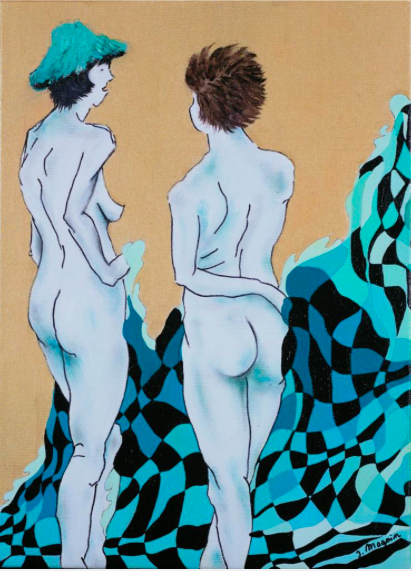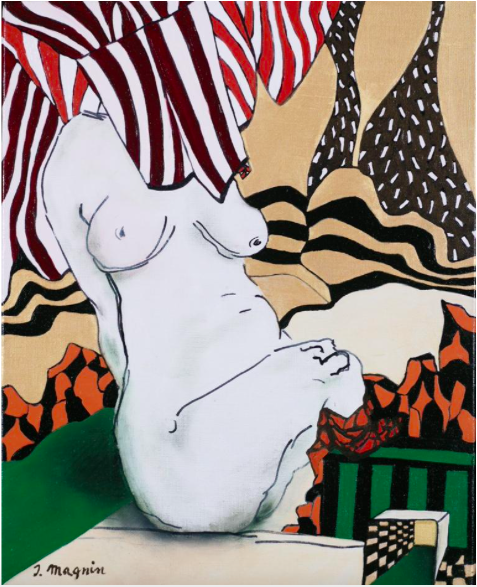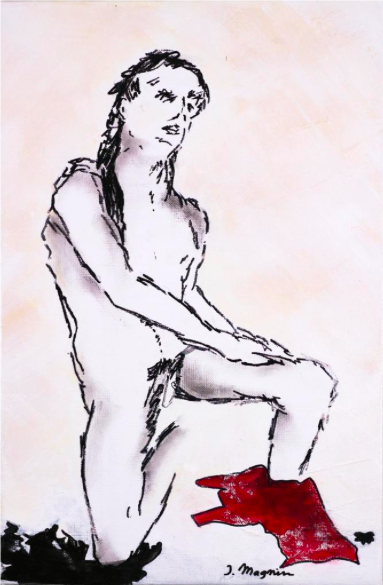Isabelle Magnin, a French artist, has always experienced the world visually, with images shaping her perception. From the age of seven, drawing and painting became integral to her life. However, her passions extended beyond art. She pursued science, focusing on mathematics, physics, and algorithms, which led her to a successful career as a Medical Imaging researcher at INSERM. Her work in the field of medical science allowed her to collaborate with researchers across the globe, earning her accolades such as the European Federation for Non-Destructive Testing’s gold medal in 1994 and being awarded the title of Chevalier de la Légion d’honneur in 2015.
Magnin’s artistic expression mirrors her fascination with the complexity of both nature and the human spirit. Her paintings, which blend traditional oil techniques with digital media, explore the delicate balance between connection and emotion. Influenced by the Renaissance, Surrealism, and artists like Niki de Saint Phalle and Klimt, her art reflects a harmony of classical and modern styles. Magnin’s pieces are now shared with audiences worldwide, including in Europe, Canada, and the United States.

The “Milky Nudes” series (“Nus lactés”) offers an intimate view into the interwoven themes of vulnerability and nature. Through three works, The Wave, Hidden Face, and Timothée, Magnin brings the viewer into her world, where personal emotion meets universal experience, captured in a combination of oil and ink.

The Wave (La Vague) presents two women immersed in a moment of liberation, sitting by the sea, letting the waves wash over them. This piece captures their peaceful interaction with nature, where the water serves as both backdrop and metaphor. Magnin illustrates the waves as a fluid, constantly changing mesh, symbolizing the ever-shifting tides of life. The ocean’s movement becomes a reflection of life’s uncertainty, while its nurturing presence highlights the healing that nature offers.
The painting’s vibrant oil and fluid ink strokes emphasize the contrast between the women’s stillness and the wave’s energy. As the ink ripples around their forms, the viewer is reminded of how fleeting moments of peace can be, like water that slips through one’s fingers. It is a visual meditation on the impermanence of joy, encouraging us to cherish these small freedoms.

In Hidden Face (Face cachée), Magnin introduces a more introspective tone. The seated woman, her legs folded, becomes almost sculpture-like, her head concealed beneath an awning. This concealment raises questions—has she turned away from the world, or is she grappling with inner conflict? The ambiguity in her pose speaks to the complexities of self-awareness and emotional retreat.
The painting’s golden backdrop, reminiscent of Klimt’s elaborate style, adds a richness that contrasts with the woman’s hidden form. This contrast serves to underscore the tension between outward beauty and inner turmoil. Magnin invites the viewer to contemplate the reasons behind this concealment, leaving the narrative open to interpretation—whether the figure is hiding from judgment or taking refuge in her own world.
Timothée introduces a male figure into the series, bringing a different energy to the collection. The scene shows Timothée kneeling, surrounded by torn clothing, leaving the viewer to interpret the cause of his disarray. Magnin leaves the context vague—was this the aftermath of a fight, a competition, or an internal struggle? His posture speaks to both defeat and resilience, capturing a moment of reflection after a challenge has passed.
This painting diverges from the more abstract exploration seen in the previous works, offering a more narrative-driven experience. The viewer is encouraged to imagine what might have occurred, reflecting on the nature of struggle, whether external or personal. The painting’s rawness adds depth to the collection, showing that even in moments of apparent defeat, there is a complexity that transcends the surface.
Isabelle Magnin’s “Milky Nudes” collection artfully combines narrative and emotional depth through her use of oil and ink. Each piece tells a story while encouraging personal reflection, inviting the viewer to explore their own emotions alongside the characters portrayed. With a focus on connection, complexity, and introspection, Magnin’s work blurs the line between the individual and the universal, offering a visual experience rich with meaning.

